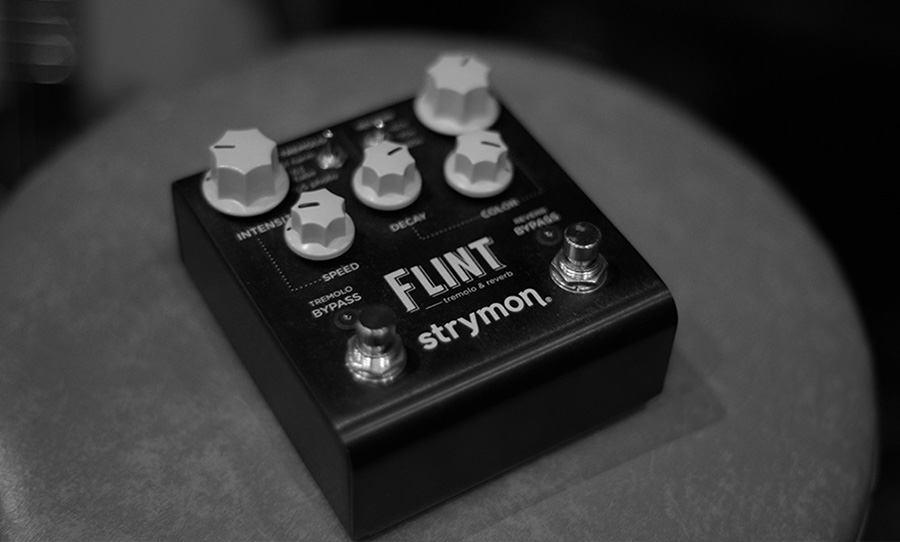For the lovers of vintage guitar tones, the combination of reverb and tremolo surely ranks highly among the “must-have” effects chains. The spring reverb and tremolo built into the classic combos like the Fender Deluxe Reverb offers up the sound best described with the hackneyed term, iconic. As dreamy as these colours of tone are, in the configuration of an amp, are somewhat limited in versatility.
This is where Strymon has stepped into the breach with their charcoal hued stompbox, the Flint. Yep, it gives you the vintage delights of the 60s-era Fender amps as well as more extreme emulations from the more recent past.
Exuding impeccable replications of reverb and tremolo sounds plucked from the 60s, 70s and 80s, the Strymon Flint is at the tops of the game in both fields.
A Tale of Two Sounds
Trem
“We want to build products with no compromises” reads the philosophy of Californian pedal manufacturer, Strymon. And throughout their short history, their reputation for creating tonemakers in keeping with their philosophy is formidable. The Flint slots in amid the stable of high quality boutique effects out there while maintaining a character all of its own.
The face of the pedal provides well-spaced tonal shaping options for tremolo on the left and reverb on the right, with each sound yielding three distinct flavours. On the tremolo side, the ‘61 Harmonic Tremolo features a gentle dual band filtering that boosts the high and low end frequencies; the ‘63 Power Tube, which emulates the fluctuating gain of vintage power tube currents which lends a swampy character to the signal; the ‘65 Photocell Tremolo, which used a dimmer to control the signal level results in easily the ‘choppiest’ of the tremolo options.
Verb
On the reverb side, the three options include a 60s-style spring reverb, a dual tank recreation that delivers more complex reflections with differing delay times for all the surf and spaghetti western you can handle; the 70’s electronic plate reverb style emulates the multi-tap digital designs of early digital reverb units, resulting in rich, smooth and endless ambience; lastly the 80s hall rack reverb is an homage to the digital microprocessors units of the late 80’s – the upward slope of the reverb tail is the distinguishing characteristic of this selection.
Needless to say, this array of choice reflects a massive chunk of recorded history to lean on. The tremolos range from the warbly, glassy waves of the 61 harmonic trem through to the How Soon is Now extremity of the 65 photocell and everything in between.
The reverbs are springy in 60s mode, the 70s and 80s modes are smooth and nigh on eternal when the decay is liberally applied. Such is its user friendliness, this unit holds its own when reamped and used as an outboard effect on any instrument, with its reverbs especially pleasing on percussion and vocals.
Unprecedented Versatility: Primary and Secondary Controls
The joy of this pedal is that it delivers an authentic tonal tribute to its ancestors, while giving the player ease of use and depth of control. The tremolo intensity and speed knobs yields what you’d expect.
Yet under the hood, the secondary control (accessed by holding down both the tremolo and reverb bypass buttons simultaneously) of the intensity knob lends a 3dB boost or cut to the tremolo path, the speed switches between rhythmic increments, when using an external tap tempo switch.
The reverb controls manipulate decay time, the mix between dry and wet sound and also colour – which all the way to the left conveys a darker equalisation, to the right, a toppier presentation.
The decay knob switches the order of effects, left equals reverb, then tremolo, the right side is tremolo, then reverb. The mix knob offers the same 3dB boost or cut, just like the intensity knob on the tremolo.
Strymon deserves its plaudits on multiple fronts – their designs are at the vanguard of digital emulation, the quality of sound is industry best. Perhaps most interestingly regarding the Flint are the palette of tonal colours so easily at the disposal of the player. At a flick of a switch, a definitive history of tremolo and reverb is accessed, with a turn of a knob, the intensity and colour of the effect is changed dramatically.



